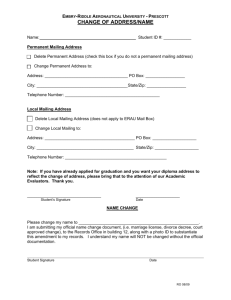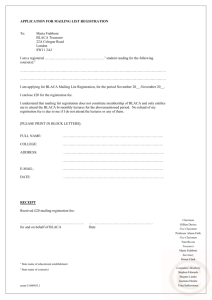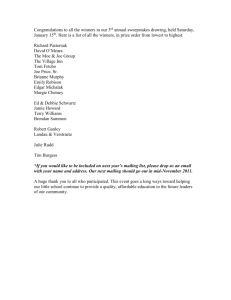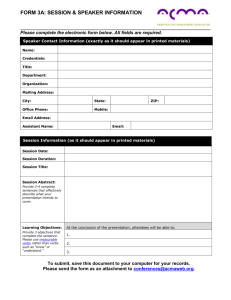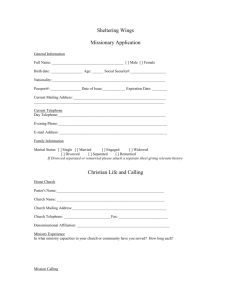gmg Glossary of Terms (AKA a quick tour round the
advertisement
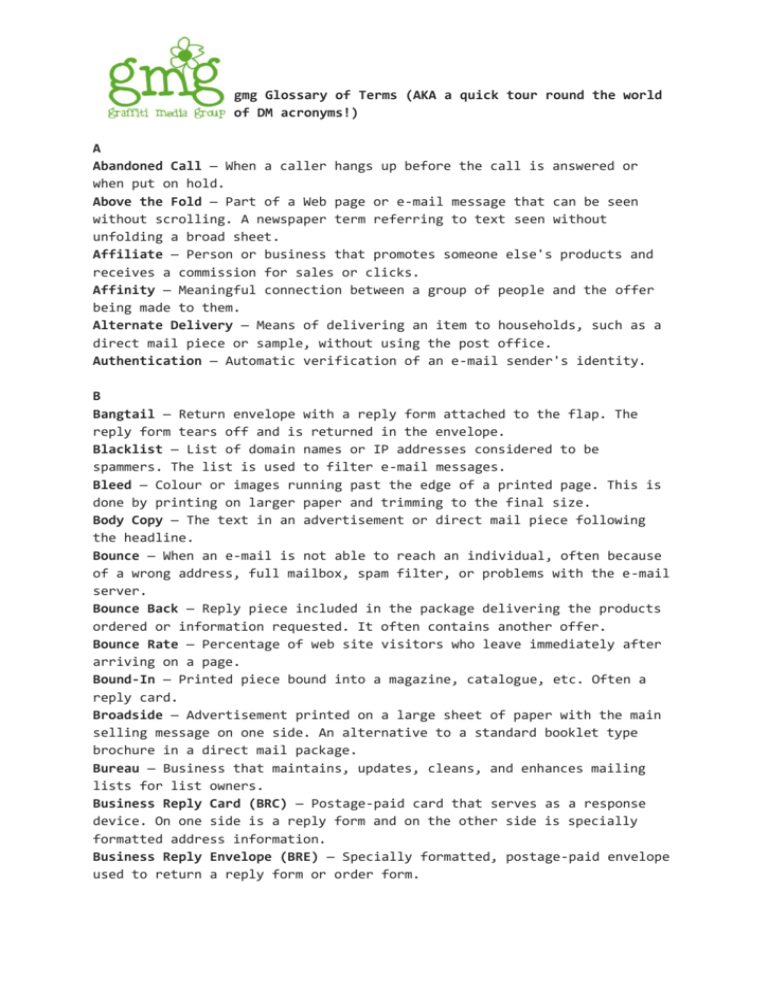
gmg Glossary of Terms (AKA a quick tour round the world of DM acronyms!) A Abandoned Call — When a caller hangs up before the call is answered or when put on hold. Above the Fold — Part of a Web page or e-mail message that can be seen without scrolling. A newspaper term referring to text seen without unfolding a broad sheet. Affiliate — Person or business that promotes someone else's products and receives a commission for sales or clicks. Affinity — Meaningful connection between a group of people and the offer being made to them. Alternate Delivery — Means of delivering an item to households, such as a direct mail piece or sample, without using the post office. Authentication — Automatic verification of an e-mail sender's identity. B Bangtail — Return envelope with a reply form attached to the flap. The reply form tears off and is returned in the envelope. Blacklist — List of domain names or IP addresses considered to be spammers. The list is used to filter e-mail messages. Bleed — Colour or images running past the edge of a printed page. This is done by printing on larger paper and trimming to the final size. Body Copy — The text in an advertisement or direct mail piece following the headline. Bounce — When an e-mail is not able to reach an individual, often because of a wrong address, full mailbox, spam filter, or problems with the e-mail server. Bounce Back — Reply piece included in the package delivering the products ordered or information requested. It often contains another offer. Bounce Rate — Percentage of web site visitors who leave immediately after arriving on a page. Bound-In — Printed piece bound into a magazine, catalogue, etc. Often a reply card. Broadside — Advertisement printed on a large sheet of paper with the main selling message on one side. An alternative to a standard booklet type brochure in a direct mail package. Bureau — Business that maintains, updates, cleans, and enhances mailing lists for list owners. Business Reply Card (BRC) — Postage-paid card that serves as a response device. On one side is a reply form and on the other side is specially formatted address information. Business Reply Envelope (BRE) — Specially formatted, postage-paid envelope used to return a reply form or order form. Business-to-Business (B-to-B or B2B) — Type of marketing where businesses offer products and services to other businesses. C Call to Action (CTA) — Part of the written message that tells the reader to respond and provides an easy means of doing so, with a toll-free number for example. Card Deck — Stack of postcards mailed together in an envelope, each card promoting a different product or service. Carrier — Another name for the outer envelope in a direct mail package. Cheshire Labels — Labels preprinted with mailing addresses and affixed to a mail piece. Circulation — Distribution count for a publication, including paid and unpaid subscriptions. Cleaning or cleansing — Process of removing unwanted data from a mailing list, including undeliverable addresses and duplications. Clickthroughs — The number of people who click a link in an e-mail message. Can be used to calculate the "clickthrough rate" for an e-mail message. Close Rate — In lead generation, the percentage of sales calls resulting in a sale. CMYK — The ink colors in a four-color printing process: cyan, magenta, yellow, and black. Compiled List — Type of mailing list created by collecting names and addresses from public records, directories, and other sources. The least targeted type of mailing list. Continuity Program — Arrangement where customers agree to a series of regular, small purchases over time. For example, a series of books shipped and paid for at a rate of one per month. Control — The most successful direct mail piece or ad, determined after testing against other direct mail pieces or ads. Conversion Rate — The percentage of inquiries that result in a sale. Co-op Mailing — Mailing with offers from multiple businesses. CPI (Cost Per Inquiry) — The cost of your campaign divided by the number of inquiries you receive. This tells you how much you have spent to acquire one inquiry or potential buyer. Cost Per Piece — Total cost of a mailing divided by the number of pieces mailed. Includes list rental, printing, and postage. The cost of copywriting and design are sometimes included, but not always since this is generally a one-time cost. CPM (Cost Per Thousand) — The cost to deliver your message to 1,000 people or the purchase price of 1,000 names of a mailing list. (The M is from the Roman numeral which stands for 1,000.) CPO (Cost Per Order) — The cost of your campaign divided by the number of orders you receive. This tells you how much you have to spend to acquire one customer. Coupon — Reply form within the design of a printed ad. May also refer to a reply card in a direct mail package. CRM (Customer Relationship Management) — Strategy for boosting revenue and customer satisfaction by improving the customer experience with a company and its products and services. Cross Sell — Encourage established customers to buy different but related products. Getting a computer buyer to purchase a printer, for example. D Data Card — Collection of information describing the characteristics of a mailing list. Data Mining — Discovering patterns and relationships within customer data to reveal what customers want and how they act. Database — Collection of personal and/or transactional information about customers or prospective customers. The repository of information about a company's relationships with people. Database Modelling — Predicting customer behaviour by using statistical techniques. Demographics — Statistical information about groups of people, such as age, sex, income, education, etc. Direct Mail — Medium used to deliver advertising directly to postal addresses, including envelopes, self-mailers, postcards, flyers, and catalogs. Do Not Call List — List of people who do not wish to receive telemarketing calls. DPI — Short for Dots Per Inch. In printing, the number of ink dots that fit into a 1" x 1" square. Double Opt-In — Technique for double checking that e-mail subscribers actually want a subscription. They must subscribe then confirm the subscription. Drop Date — Scheduled day when a mailing is to be delivered to the post office. DRTV — Short for Direct Response Television. Medium used to deliver ads to TV viewers and asking for an immediate response. Dupe — Short for duplicate or duplication. Names that appear more than once in a mailing list. E ECOA — Short for E-mail Change of Address, a system to help update e-mail address lists. E-mail Appending — Adding individual e-mail addresses to an database of names and postal addresses. E-mail Filter — Software that blocks incoming e-mail based on sender address, subject matter, or other factors. F Flyer (or Flier) — Promotional piece created from a single sheet and usually not folded. Smaller than a broadside. Frequency — For a given customer, the average number of purchases within a certain time period, such as 2 purchases per month. Fulfillment — The process of responding to a customer purchase or request, including shipping ordered products. G Gatefold — Parallel folds on printed piece resulting in flaps folding toward each other like a gate. GIF — Acronym for Graphics Interchange Format, a type of graphic format used on web sites. H Hard Bounce — When an e-mail message is rejected or "bounced" because of a bad address. Hotline List — The most recent additions to a mailing list representing those who have just made a purchase and are therefore desirable customers. House List (or House File) — List of buyers and prospects maintained by a company. This is the most valuable asset for any direct marketer. HTML — Short for Hyper Text Markup Language, the programming language used to create Web pages. Hyperlink — Text on a Web page or in an electronic document which can be clicked with a mouse to open another page or document. I Insert Media — Print media delivering advertising to consumers by means other than solo direct mail or space advertising. Includes card decks, cooperative mailings, statement stuffers, package inserts, blow-ins or bind-ins, and free-standing inserts. IP Address — Short for Internet Protocol address, a unique number identifying a device connected to the Internet. ISDN — Acronym for Integrated Services Digital Network, a set of standards for telephone transmission technology. ISP — Acronym for Internet Service Provider, a company providing access to the Internet. J JPEG — Acronym for Joint Photographic Experts Group, a type of compressed graphics file used primarily for color images on Web sites. K Key Code — See Source Code. L Landing Page — Web page that is reached when a link is clicked, specifically a special page designed to receive traffic from particular links. Lead — Person identified as a potential client or customer after asking for information or meeting certain buying criteria. Generally a more qualified possibility than a "prospect." Lead Generation — Process of gathering prospective customers for further marketing. Lifetime Value — Net profit a customer is likely to generate during their relationship with a company. List — Collection of data that may include names, addresses, phone numbers, e-mail addresses, and other information for a group of people who share a common characteristic, such as being sports car owners or doctors. List Broker — Person or business that helps locate and purchase lists that are appropriate for a given direct mail or e-mail campaign. Loose Insert — Printed advertisement inserted, but not bound, into a publication. M /M — Per thousand /000 Magalog — Direct mail sales format that looks like a magazine or catalog. Mail Preference Service — Service of the Direct Marketing Association allowing people to remove their names from mailings lists (at least from lists of mailers who cooperate with the program). Merge/Purge — Combining two or more lists while simultaneously removing duplicate data. Multiple Buyer — Customer who has made purchases more than once. Also called "repeat buyer." N National Change of Address (NCOA) — Means provided by the U.S. Postal Service to correct addresses on a mailing list prior to mailing. Negative Option — Type of offer where the customer agrees to ongoing shipments or purchases of a product or service, which will stop only when the customer asks for them to stop. One example is a book of the month club. O Offer — The deal you propose to a potential buyer to encourage a purchase. The offer includes price, guarantee, premiums, etc. Open Rate — Number of people who open an e-mail message divided by the total number of e-mail messages sent. Opt-In — To grant permission for a company to send e-mail by making a direct request to be included on a mailing list. Opt-Out — To decline permission for a company to send e-mail by making a direct request to be excluded from a mailing list. Outsourcing — Hiring someone outside a company to do work. P Package — Direct mailing consisting of an envelope and all its contents, including a letter, order form, brochure, etc. Package Insert — Promotional piece sent along with a product shipment. Some businesses make additional revenue by including inserts from other companies. Paid Circulation — Distribution of a publication to those who pay for a subscription. (See Controlled Circulation.) Pass Along — Readership of a publication or mailing beyond the original recipient. Also a printed piece intended to be passed on to someone else. Personalisation — Inserting a person's name or other unique information into the message of an advertisement. Phishing — Method for identity theft using what appears to be a legitimate e-mail message to get people to reveal personal information, such as credit card or bank account numbers. Pop-Up — Ad or message that "pops up" in your browser window. Positive Option — Type of offer where the customer is given the opportunity to purchase repeatedly, but where there is no implied obligation. No products or services are provided until the customer asks for them. Prospect — Someone who has been identified as a potential customer or client. Prospecting — Process of finding potential customers by advertising specifically to groups of non-customers. Psychographics — Descriptive information about groups of people, such as lifestyle, attitudes, and values. Purge — Cleaning technique for mailing lists which removes bad addresses, duplicates, or undesirable names. R Recency — Time since the latest purchase or activity for a person or business. Reply Card — A card in a mailing used by the recipient to reply to the offer. Response Device — The part of a direct mail piece or ad returned to the advertiser, such as an order form, reply card, or coupon. Response Rate — The number of responses to an offer divided by the total number of people who received the offer. Generally stated as, "That mailing generated a 5 percent response." Retention — Efforts by a company to keep customers or clients from defecting to the competition. Return on Investment (ROI) — Money earned compared to money spent, a figure used to determine how profitable a business is. RFM — Acronym for Recency, Frequency, Monetary value. A formula used to predict the potential sales of a given universe of prospects. RGB — Stands for Red, Green, Blue. The color system used primarily by computer and television monitors to produce color images. Roll Fold — A way of folding paper similar to how you would fold a letter, so that all the folds are in the same direction. Rollout — Mailing to the rest of a mailing list after testing the mail piece on a smaller sample of that list. S Salutation — The part of a letter that addresses the reader, such as "Dear Friend" or "Dear Sally." Self-mailer — A piece of direct mail without an envelope. Technically, this can include catalogues, booklets, slim-jims, folded mailers, and postcards. However, the term usually refers to a folded mailer. Seed — Name included in a mailing list to catch people who disregard the terms of the list rental agreement. If the agreement is a one-time rental and the renter mails to the list more than once, the seed will receive the mailing and inform the list owner. Seeding — Adding names to a mailing list to reveal unauthorised use. Segmentation — Dividing potential buyers into smaller groups based on buying patterns or demographic information. Selections — Sub-groups of a mailing list based on geographic location, age, gender, or other information. Used to fine tune a marketing effort. Sorting — Organizing a list into a particular sequence, for example by name, company, or ZIP code. Source Code — Also called "key code." A series of letters and/or numbers placed on a reply device to help identify the source of the reply. For example, if you mail the same package to two lists, the source code will identify which list generated each reply. Space Advertising — Ads placed in print publications. Spam — Unsolicited or unwanted commercial e-mail. Split Test — Technique used to test an offer or message for the same audience at the same time. For example, you could run two different ads in the same print run of a magazine to see which is most effective. Spoofing — Masking a sender's e-mail address with a fake address to make the recipient think the message is from a trusted source. Spyware — Software that tracks and communicates computer activity, usually without the user knowing about it. Statement Stuffer — Small promotional piece inserted into an envelope that contains a billing statement. T Take-One — Promotional literature (usually one sheet) placed in hightraffic areas, such as grocery stores. Teaser — Words that create curiosity and make the reader want to know more. Usually found on the outside of an envelope to encourage the recipient to look inside. Telephone Preference Service — Service of the Direct Marketing Association allowing people to remove their names from telemarketing lists (at least from lists of telemarketers who cooperate with the program). Throwaway — Cheaply printed ad or flyer used for mass distribution where the response is expected to be low. Most people will throw it away, so it must be economical. Tip On — Usually refers to an item that is glued to a printed piece, such as a reply card "tipped on" to a mailing piece. Traffic Builder — Any advertising effort intended to draw people to a certain place, such as a store or a Web site. Trim Size — Size of a printed piece after it has been printed on a larger sheet then cut to its final size. U Universe — The total group of people or businesses that are being targeted in a campaign or all those who are potential buyers for a product or service. V Variable Data Printing — See Personalisation. W Web Press — High-speed printing press using paper from a large continuous roll instead of inserting individual sheets.
